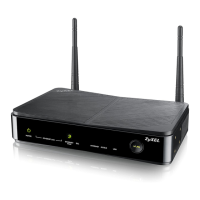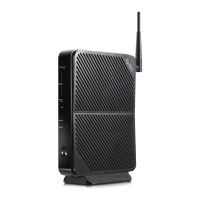Chapter 14 AP Profile
SBG3500-N Series User’s Guide
232
Beacon Interval When a wirelessly networked device sends a beacon, it includes with it a beacon
interval. This specifies the time period before the device sends the beacon again. The
interval tells receiving devices on the network how long they can wait in low-power
mode before waking up to handle the beacon. A high value helps save current
consumption of the access point.
DTIM Delivery Traffic Indication Message (DTIM) is the time period after which broadcast and
multicast packets are transmitted to mobile clients in the Active Power Management
mode. A high DTIM value can cause clients to lose connectivity with the network. This
value can be set from 1 to 255.
Output Power Set the output power of the AP in this field. If there is a high density of APs in an area,
decrease the output power of the NWA5160N to reduce interference with other APs.
Select one of the following 100%, 50%, 25%, or 12.5%. See the product
specifications for more information on your SBG3500-N Series’s output power.
Note: Reducing the output power also reduces the SBG3500-N Series’s effective
broadcast radius.
Signal Threshold Use the Received Signal Strength Indication (RSSI) threshold to ensure wireless clients
receive good throughput. This allows only wireless clients with a strong signal to
connect to the AP.
Clear the check box to not require wireless clients to have a minimum signal strength
to connect to the AP.
Station Signal
Threshold
Enter a Received Signal Strength Indication (RSSI) threshold and set a minimum client
signal strength for connecting to the AP. -20 dBm is the strongest signal you can
require and -76 is the weakest.
Disassociate
Station
Threshold
Enter a Disassociation Station Threshold and set a minimum client signal strength for
disconnecting the AP. -20 dBm is the strongest signal you can require and -90 is the
weakest.
Allow Station
Connection after
Retries
Click this check box to allow client APs to retry to connect to the SBG3500-N Series.
Station Retry
Count
Enter a number that a client AP can try to reconnect to the SBG3500-N Series. The
range is from 1 to 100.
Rate Configuration This section controls the data rates permitted for clients.
For each Rate, select a rate option from its list. The rates are:
• Basic Rate (Mbps) - Set the basic rate configuration in Mbps.
• Support Rate (Mbps) - Set the support rate configuration in Mbps.
• MCS Rate - Set the MCS rate configuration. IEEE 802.11n supports many different
data rates which are called MCS rates. MCS stands for Modulation and Coding
Scheme. This is an 802.11n feature that increases the wireless network
performance in terms of throughput.
Multicast Settings Use this section to set a transmission mode and maximum rate for multicast traffic.
Transmission
Mode
Set how the AP handles multicast traffic.
Select Multicast to Unicast to broadcast wireless multicast traffic to all of the wireless
clients as unicast traffic. Unicast traffic dynamically changes the data rate based on the
application’s bandwidth requirements. The retransmit mechanism of unicast traffic
provides more reliable transmission of the multicast traffic, although it also produces
duplicate packets.
Select Fixed Multicast Rate to send wireless multicast traffic at a single data rate.
You must know the multicast application’s bandwidth requirements and set it in the
following field.
Multicast Rate
(Mbps)
If you set the multicast transmission mode to fixed multicast rate, set the data rate for
multicast traffic here. For example, to deploy 4 Mbps video, select a fixed multicast
rate higher than 4 Mbps.
Table 73 Network Settings > AP Profile > Add/Modify New Profile (continued)
LABEL DESCRIPTION

